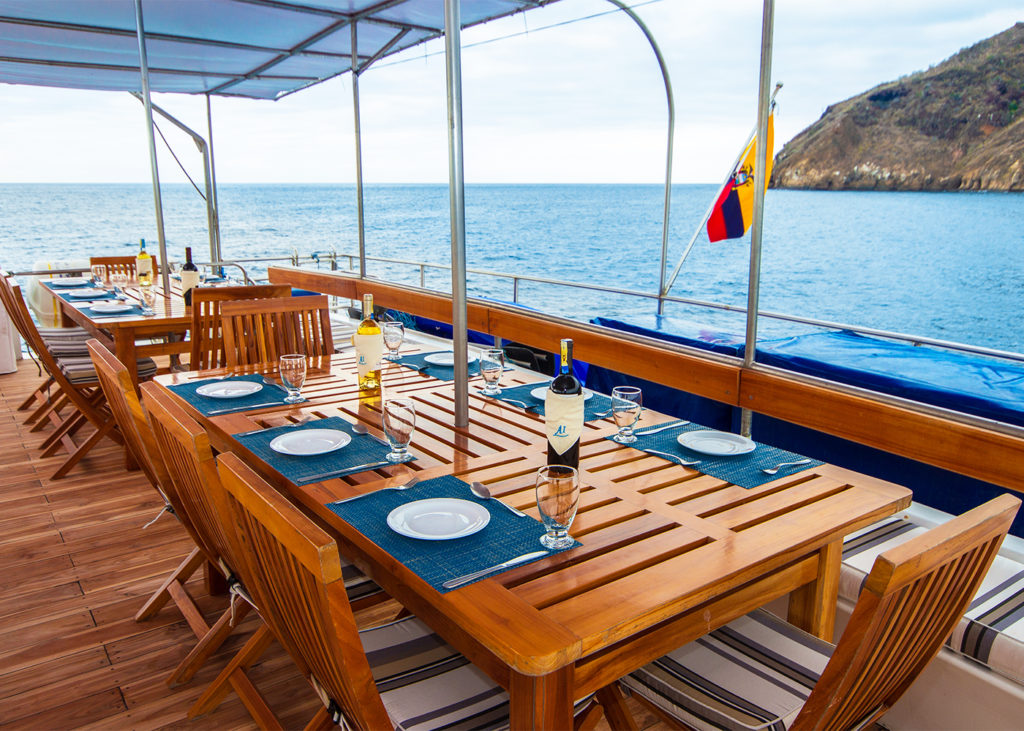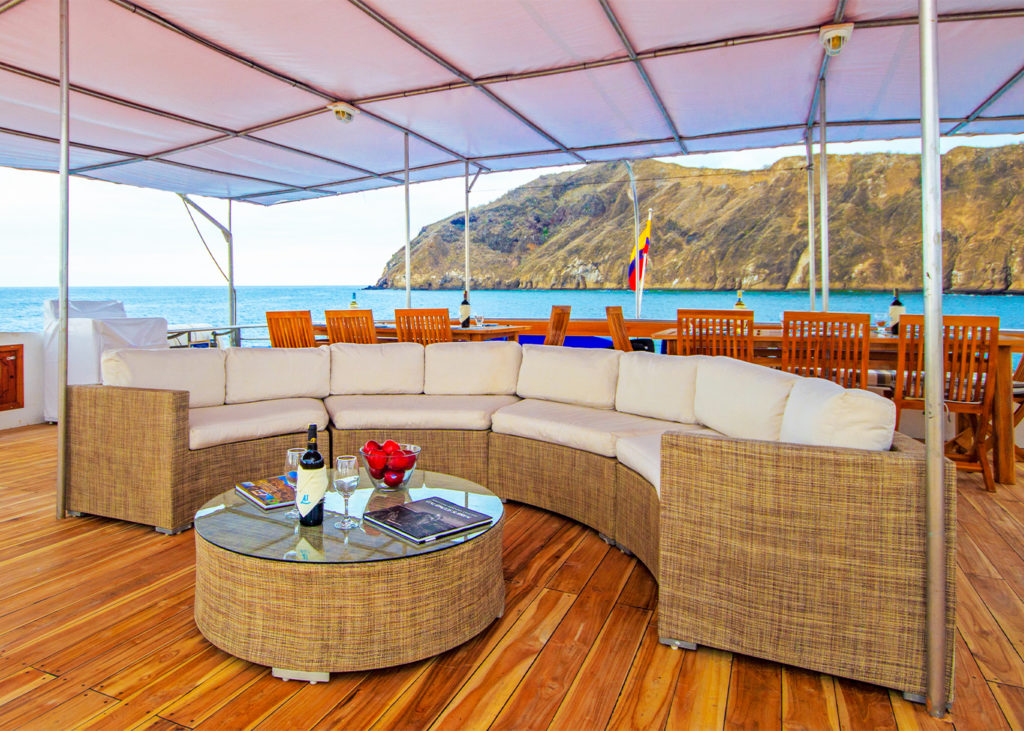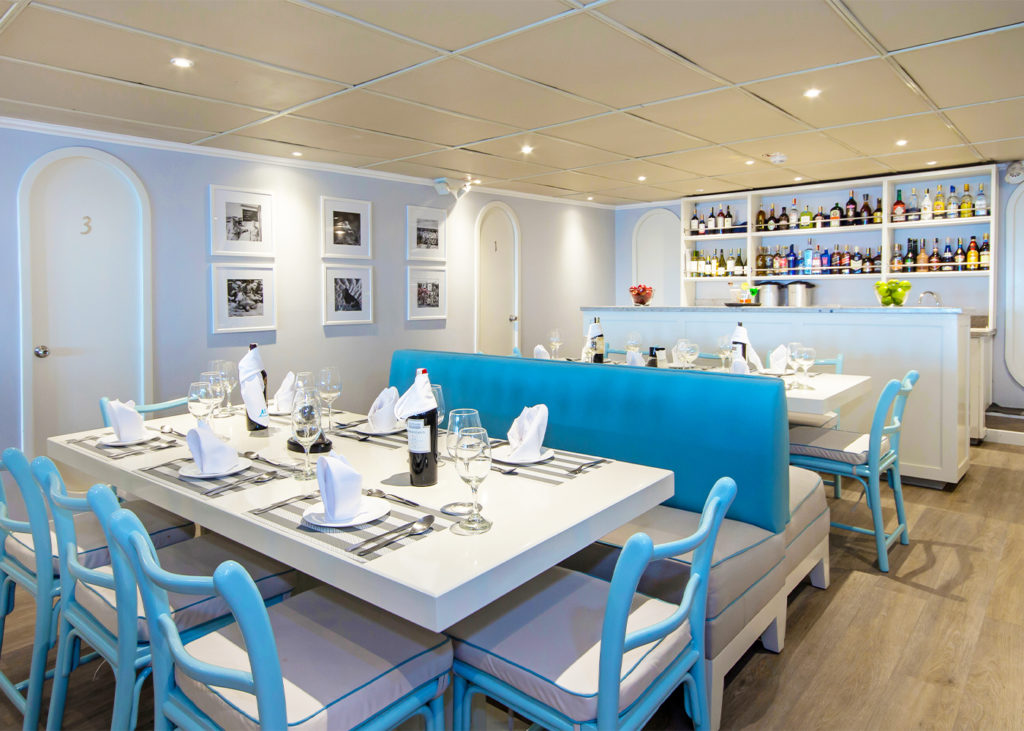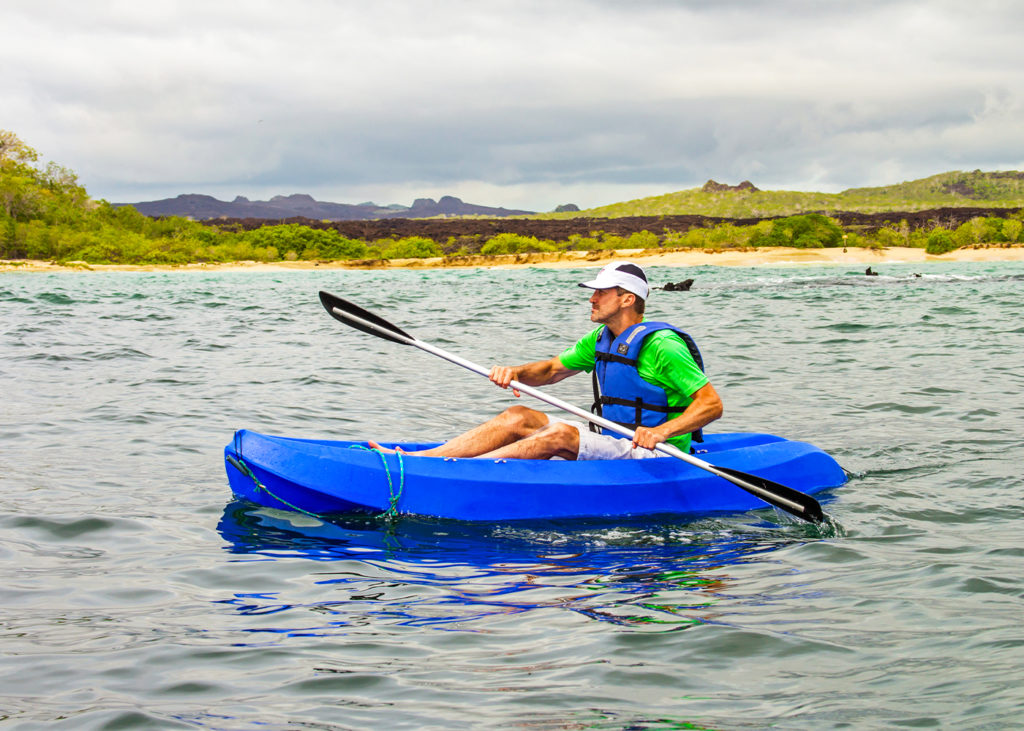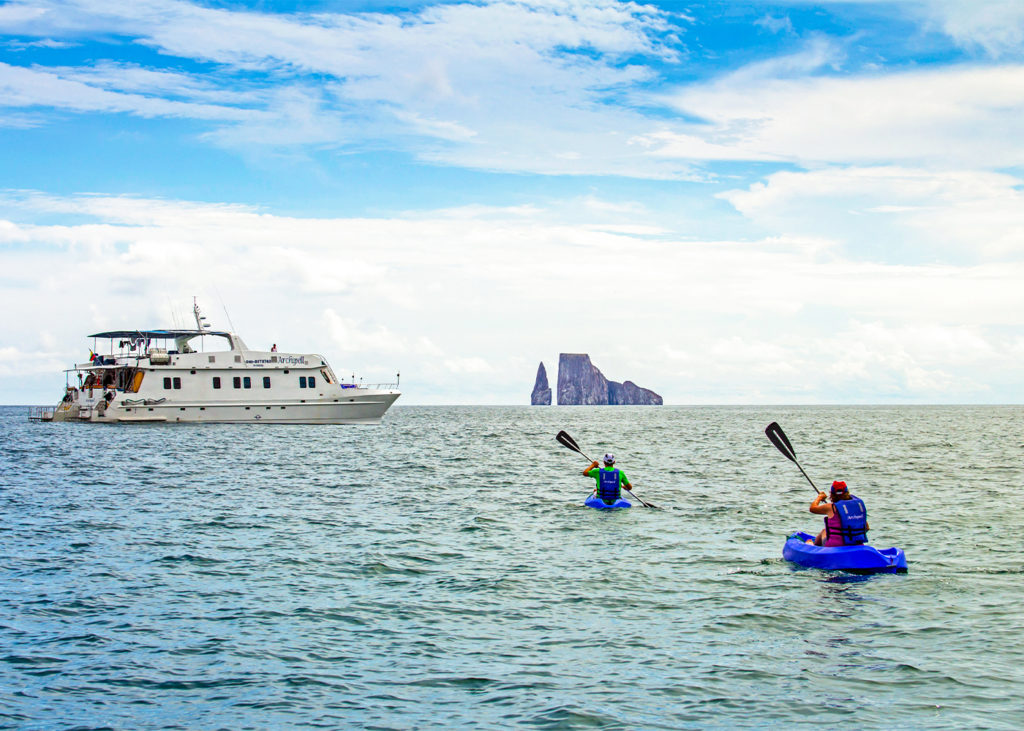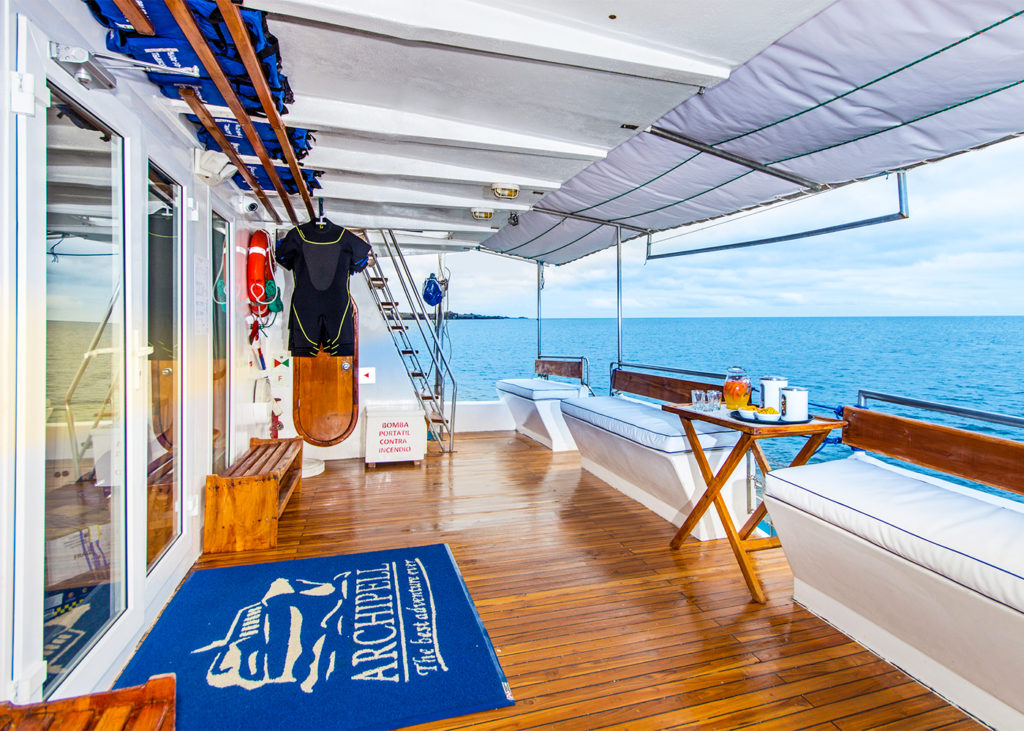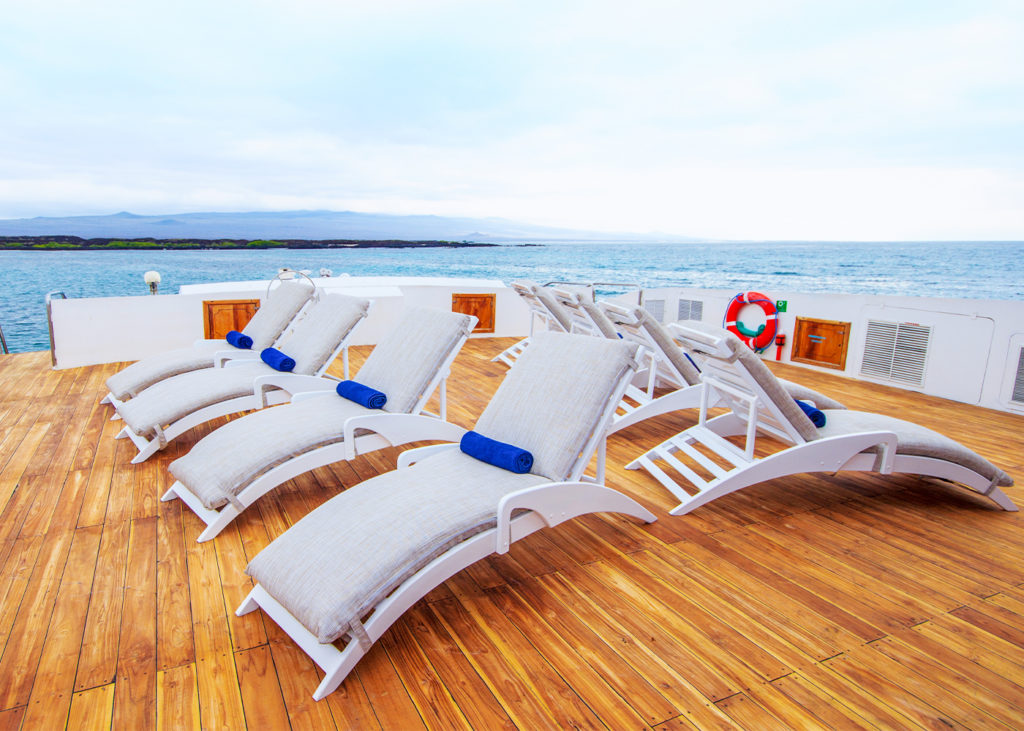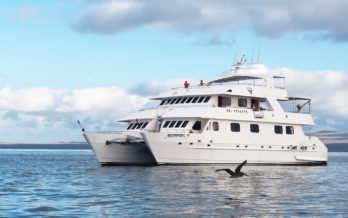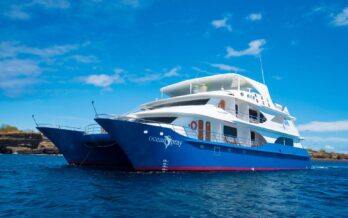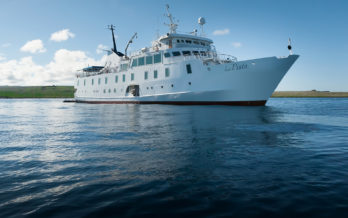Cruise Overview
Motor Catamarans Archipel I & II cruise around the great outdoors of the breathtaking Galapagos Archipelago, where you will keep discovering one surprise after another! Every day we anchor at two selected visitor’s sites and organise at least two excursions.
You will observe nature from different perspectives with our balanced excursion programme, or even during your spare time.
Cabin Types
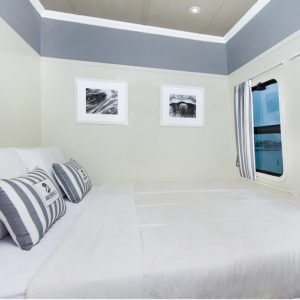
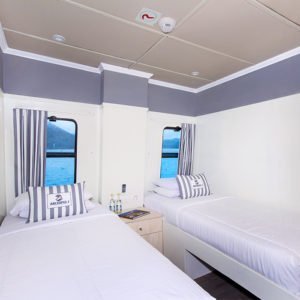
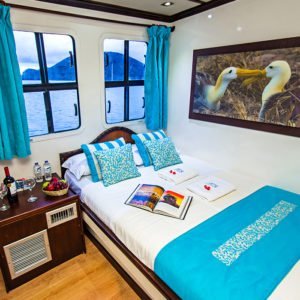
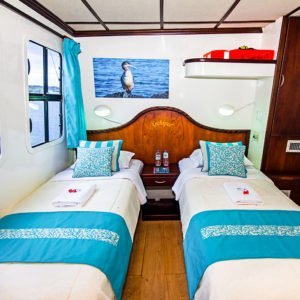
Archipel I
Departs Monday
8 Days / 7 Nights
Upon arrival at San Cristóbal Airport, travellers pass through an airport inspection point to
make sure that no foreign plants or animals are introduced to the islands, and to pay the park
entrance fee of $100 (unless it has been prepaid). A guide will meet you, help you collect your
luggage, and escort you on a short bus ride to the harbour.
Afternoon Excursion: Cerro Colorado (San Cristóbal)
Cerro Colorado Tortoises Protection and Growing Centre, located approximately 40 minutes by
bus from the southeast of the island, was built to improve the status of the population of the
island tortoises. The centre includes a large corral, a Visitor Centre, breeding centre and an
interpretative trail. Along this trail, it is possible to see different species of native and endemic
plants as well as birds like the San Cristóbal mockingbird, yellow warblers, many species of
finches and the Galapagos flycatcher.
Morning Excursion: South Plaza
South Plaza is located at the east of Santa Cruz Island, and forms part of two islands known as
Islas Plazas. Despite its small size, some of the most interesting and outstanding species of the
Galapagos are found here. The Plazas land iguanas are smaller than their relatives found on
other islands. There are several hybrid iguanas, a result of crossing a male marine iguana and a
female land iguana; they are unique, recognisable at first glance by their black/grey color, with
a land iguana’s crest, but face and tail of the marine iguana. The large population of iguanas is
due to the presence of tuna, their favourite food. Swallow-tailed gulls nesting in the rugged
cliffs are seen along with other seabirds such as Audubon shearwaters, red-billed tropicbirds,
frigate birds and brown pelicans.
Afternoon Excursion: Santa Fe
Located in the southeastern part of the Galapagos, this island was formed from an uplift rather
than being from a volcanic origin; which is why it is mostly flat. There are some theories
claiming that this could be the oldest island in the archipelago. Santa Fe is home to a number
of endemic species like the Galapagos Hawk, Galapagos snake, Galapagos mockingbird, rice
rats and one of the two species of land iguanas on the islands. After disembarking into the
beautiful and clear waters, you will be in contact with one of the many sea lion colonies. Along
the trail, many saltbushes can be seen, as well as giant Prickly pear cactus. There are great
possibilities of snorkelling with playful sea lions and tropical fish.
Morning Excursion: Champion Islet (Floreana)
Bottlenose dolphins frequently escort our passage to Champion Islet and you can see them
from nearby jumping the wakes! Underwater, Galapagos sea lions are playful acrobats that
become the number one attraction. There are also lots of reef fish, and perhaps a green Pacific
turtle.
An inflatable dinghy ride along the shoreline of this islet offers sightings of lots of seabirds that
are endemic to the archipelago, including Galapagos penguins, blue-footed boobies,
magnificent frigate birds and red-billed tropicbirds, swallow-tailed gulls and lava herons.
A birdwatchers dream is to get a glimpse of the Charles mockingbird on top of prickly pear
cacti. This mockingbird is a scientific and historic key species, because it put Darwin on track of
his theory of ‘adaptive radiation’.
Afternoon Excursion: Loberia & Asylum of Peace (Floreana)
The Asylum of Peace Island is of historical interest for guests. This hike goes past a
mesmerising cave and visits a fascinating freshwater spring. La Loberia beach is an ideal spot to
enjoy the ocean, as well as the playful sea lions that reside there.
Morning Excursion: Charles Darwin Research Station
Although the great majority of Galapagos visitors come here to observe and appreciate natural
wonders, it is also interesting to learn how the protection and conservation of the islands are
done. The main attractions are the National Park information centre, the Van Staelen
Exhibition Hall, the Breeding and Rearing Centre for young tortoises, and adult Galapagos
tortoises in captivity.
Morning Excursion: Highlands (Santa Cruz)
The road to the highlands leaves from Bellavista, a small village located a 15-minute drive from
Puerto Ayora and passes through the agricultural zone, near the National Park boundary, the
Miconia Zone, and then goes to the Fern and Sedge zone. With clear weather, this area gives
you beautiful scenes of rolling hills and extinct volcanic cones covered with grass and lush
greenery all year round. Here you will visit the Twin Craters, which are two pit craters, as well
as a local ranch where we can observe the Giant tortoise of Santa Cruz Island in its natural
habitat.
Morning Excursion: Tintoreras Islet
“Tintoreras” are small islands in front of the Puerto Villamil coast. There are herons on the
lookout on mangrove branches, as well as Galapagos penguins and sea lions that often pop out
on the shore. White-tipped reef sharks (in Spanish: Tintoreras) are common in the archipelago
and are very commonly found resting in the shallow waters.
Afternoon Excursion: Tortoise Breeding Centre & Wetlands
Isabela Island is the largest and one of the youngest islands in the Galapagos archipelago. We
land in Puerto Villamil, which has the second smallest population in the Galapagos with
approximately 3000 habitants. First, we will visit Flamingos Lagoon; the largest coastal lagoon
found on the Galapagos and one of the main reproductive sites for the greater flamingos.
On your visit to Colorado Hill, you will get to discover the amazing and emblematic giant
Galapagos tortoises in the Tortoise breeding centre, and maybe even get to see one hatch
(seasonally)! In addition, you will get to see how much hard work is put into save the last local
giants of San Cristóbal
Morning Excursion: Moreno Point (Isabela)
Moreno Point is located on the north coast of Isabela Island between the volcanos Sierra
Negra and Cerro Azul. The trail runs along a solidified lava flow called “Pahohoe”, into a
complex of coastal lagoons. Its main attraction are several species of birds, which are found
around the lakes and mangroves.
Afternoon Excursion: Elizabeth Bay (Isabela)
This is a marine visitor site, so the excursion has no landing point. Your zodiac ride starts with a
visit to the Marielas islets, home to the largest and most important penguin colony on the
Galapagos Islands. The excursion continues into the cove, surrounded by red mangrove, where
you can admire their red roots and green leaves. Here, you are able to observe sea turtles,
flightless cormorants, spotted eagle rays, golden rays, brown pelicans and sea lions. Frequent
visitors have been able to see Galapagos hawks soaring overhead with schools of pompano and
dorado fish swimming down below.
Morning Excursion: Tagus Cove (Isabela)
A tour along the cliffs will give visitors a good chance to see the Galapagos penguin, the
flightless cormorant and other seabirds. From the landing dock, it is about a 30-minute hike
along the trail up to the top of the cliff from where you can view Darwin Lake, an uplifted lake
saltier than the sea. You can also see several volcanoes from this location. Look carefully at the
graffiti on the surrounding cliffs of the cove, done by pirates, whalers and buccaneers in past
centuries!
Afternoon Excursion: Espinoza Point (Fernandina)
Fernandina is the third largest island in the archipelago and has a single visitor site: Punta
Espinoza, located at the northeastern tip of the island. Here, marine iguanas conglomerate in
larger groups than on any other island. They bask around in the sand, swim near the shore and
sometimes block the way at the landing dock. Among the unique species found here, we can
find the flightless cormorant.
Morning Excursion: Bachas Beach (Santa Cruz)
These two small beaches are found to the west of Turtle Cove. Their sand is made of
decomposed coral, which makes it white and soft, and a favourite nesting site for sea turtles.
Behind one of the beaches there is a small blackish water lagoon, where it is occasionally
possible to observe flamingos and other coastal birds, such as black-necked stilts and
whimbrels. The other beach is longer, but it has two old barges that were abandoned during
World War II, when USA used Baltra Island as a strategic point to protect the Panama Channel.
Assisted by the naturalist guide and some crew members, the dinghy will bring you and your
luggage to the Seymour Ecological Airport, where we will take the shuttle back to the airport.
Archipiel I
Departs Thursdays
5 Days / 4 Nights
Upon arrival at the Seymour Ecological Airport, travellers pass through an airport inspection
point to make sure that no foreign plants or animals are introduced to the islands, and to pay
the park entrance fee of $100 (unless it has been prepaid). A guide will meet you, help you
collect your luggage, and escort you on a short bus ride to the harbour.
Afternoon Excursion: Highlands (Santa Cruz)
The road to the highlands leaves from Bellavista, a small village located a 15-minute drive from
Puerto Ayora, and passes through the agricultural zone, near the National Park boundary, the
Miconia Zone, before going to the Fern and Sedge zone. With clear weather, this area offers
beautiful scenes of rolling hills and extinct volcanic cones covered with grass and lush greenery
all year round. Here you will visit the Twin Craters, which are two pit craters, as well as a local
ranch where we can observe the giant Tortoise of Santa Cruz Island in its natural habitat.
Morning Excursion: Tintoreras Islet
“Tintoreras” are small islands in front of the Puerto Villamil coast. There are herons on the
lookout on mangrove branches, as well as Galapagos penguins and sea lions that often pop out
on the shore. White-tipped reef sharks (in Spanish: Tintoreras) are common in the archipelago
and are very commonly found resting in the shallow waters.
Afternoon Excursion: Tortoise breeding centre & Wetlands
Isabela Island is the largest and one of the youngest islands in the Galapagos archipelago. We
land in Puerto Villamil, which has the second smallest population in the Galapagos with
approximately 3.000 habitants. First, we will visit the Flamingos Lagoon; the largest coastal
lagoon found in the Galapagos and one of the main reproductive sites for the greater
flamingos.
On your visit to Colorado Hill, you will discover the amazing and emblematic giant Galapagos
tortoises in the tortoise breeding centre, and maybe even get to see one hatch (seasonally)! In
addition, you will get to see how much hard work is put into saving the last local giants of San
Cristóbal.
Morning Excursion: Moreno Point (Isabela)
Moreno Point is located on the north coast of Isabela Island between the volcanos of Sierra
Negra and Cerro Azul. The trail runs along a solidified lava flow called “Pahohoe”, into a
complex of coastal lagoons. Its main attraction are several species of birds, which are found
around the lakes and mangroves.
Afternoon Excursion: Elizabeth Bay (Isabela)
This is a marine visitor site, so the excursion has no landing point. Your zodiac ride starts with a
visit to the Marielas islets where the largest and most important penguin colony reside in the
Galapagos Islands. The excursion continues into the cove that is surrounded by red mangroves
where you can admire their red roots and green leafs. Here, you are able to observe sea turtles,
flightless cormorants, spotted eagle rays, golden rays, brown pelicans and sea lions. Frequent
visitors have been able to see Galapagos Hawks soaring overhead whilst schools of Pompano
and Dorado fish swimming down below
Morning Excursion: Tagus Cove (Isabela)
Tagus Cove, a tour along the cliffs will give the visitors a good chance to see the Galapagos
penguin, the flightless cormorant and other seabirds. From the landing dock, it is about a 30-
minute hike along the trail up to the top of the cliff from where you can view Darwin Lake, an
uplifted lake saltier than the sea. You can also see several volcanoes from this location. Look
carefully at the graffiti on the surrounding cliffs of the cove, done by pirates, whalers and
buccaneers in past centuries!
Afternoon Excursion: Espinoza Point (Fernandina)
Fernandina is the third largest island in the archipelago and has a single visitor site: Punta
Espinoza, located at the northeastern tip of the island. Here, marine iguanas conglomerate in
larger groups than in any other island. They bask around in the sand, swim near the shore and
sometimes block the way at the landing dock. Among the unique species found here, we can
find the flightless cormorant.
Morning Excursion: Bachas Beach (Santa Cruz)
These two small beaches are found to the west of Turtle Cove. Their sand is made of
decomposed coral, which makes it white and soft, and a favourite nesting site for sea turtles.
Behind one of the beaches there is a small blackish water lagoon, where it is occasionally
possible to observe flamingos and other coastal birds, such as black-necked stilts and
whimbrels. The other beach is longer, but it has two old barges that were abandoned during
World War II, when USA used Baltra Island as a strategic point to protect the Panama Channel.
Assisted by the naturalist guide and some crew members, the dinghy will bring you and your
luggage to the Seymour Ecological Airport, where we will take the shuttle back to the airport.
Archipiel I
Departs Mondays
4 Days / 3 Nights
Upon arrival at the Sin Cristóbal Airport, travellers pass through an airport inspection point to make
sure that no foreign plants or animals are introduced to the islands, and to pay the park entrance fee
of $100 (unless it has been prepaid). A guide will meet you, help you collect your luggage, and escort
you on a short bus ride to the harbour.
Afternoon Excursion: Colorado Hill / Tortoise Breeding Centre
Cerro Colorado Tortoises Protection and Growing Centre, located approximately 40 minutes by bus
from the southeast of the island, was built to improve the status of the population of island
tortoises. The centre includes a large corral, a Visitor Centre, breeding centre and an interpretative
trail. Along this trail, it is possible to see different species of native and endemic plants as well as
birds like the San Cristóbal mockingbird, yellow warblers, many species of finches and the Galapagos
flycatcher.
On your visit to Colorado Hill, you will be able to discover the amazing and emblematic giant
Galapagos tortoises in the tortoise breeding centre, and maybe even get to see one hatch
(seasonally)! In addition, you will get to see how much hard work is put into saving the last local
giants of San Cristóbal.
Morning Excursion: South Plaza
South Plaza is located to the east of Santa Cruz Island, and forms part of a pair of islands known as
“Islas Plazas”. Despite its small size, some of the most interesting and outstanding species of the
Galapagos are found here. The Plazas land iguanas are smaller than their relatives on other islands.
Throughout the island there are several hybrid iguanas, a result of crossing a marine iguana with a
land iguana. They are unique and can be recognised at first glance by their black/grey color, with a
land iguana’s crest, but face and tail of the marine iguana. The big population of iguanas is due to
the presence of tuna, their favourite food. Swallow tailed gulls nesting in the rugged cliffs are seen
along with other seabirds as: audubon shearwaters, red-billed tropicbirds, frigate birds and brown
pelicans.
Afternoon Excursion: Santa Fe
Located in the southeastern part of the Galapagos, this island was formed from an uplift rather than
being of volcanic origin, which is why it is mostly flat. There are some theories which claim that this
could be the oldest island in the Archipelago. Santa Fe is home to a number of endemic species like
the Galapagos Hawk, Galapagos snake, Galapagos mockingbird, rice rats and one of the two species
of lands iguanas of the islands. After disembarking into the beautiful and clear waters you will be in
contact with one of the many sea lion colonies. Along the trail many salt bushes can be seen as well
as the giant prickly pear cactus – gigantism is a characteristic of oceanic islands. There are many
possibilities to snorkel with playful sea lions and tropical fish.
Morning Excursion: Champion Islet (Floreana)
Bottlenose dolphins frequently escort our passage to Champion Islet and you can see them from
nearby jumping the wakes! Underwater, Galapagos sea lions are playful acrobats that become the
number one attraction. There are also lots of reef fish, and perhaps a green Pacific turtle.
An inflatable dinghy ride along the shoreline of this islet offers sightings of lots of seabirds that are
endemic to the archipelago, including Galapagos penguins, blue-footed boobies, magnificent frigate
birds, red-billed tropicbirds, swallow-tailed gulls and lava herons.
A birdwatcher’s wish is to get a glimpse of the Charles mockingbird on top of prickly pear cacti. This
mockingbird is a scientific and historic key species, because it put Darwin on track of his theory of
‘adaptive radiation’.
Afternoon Excursion: Loberia & Asylum of Peace (Floreana)
The Asylum of Peace Island is of historical interest for guests. This hike goes past a mesmerising cave
and visits a fascinating freshwater spring. La Loberia beach is an ideal spot to enjoy the ocean, as
well as the playful sea lions that live there.
Morning Excursion: Charles Darwin Research Station
Although the great majority of Galapagos visitors come here to observe and appreciate natural
wonders, it is also interesting to learn how the protection and conservation of the islands are carried
out. The main attractions are the National Park information centre, the Van Staelen Exhibition Hall,
the Breeding and Rearing Centre for young tortoises, and adult Galapagos tortoises in captivity.
Assisted by the naturalist guide and some crewmembers, the dinghy will bring you and your luggage
to the Baltra, where we will take the shuttle back to the airport
Tour Inclusions
- Accommodation as confirmed.
- All mentioned meals (full-board); filtered water, tea and coffee.
- All guided excursions & activities as mentioned in the itinerary by a National Park certified naturalist guide.
- Beach towels & snorkelling gear (snorkel, mask, flippers; optional wet-suits for hire).
Tour Exclusions
- Flights to and from mainland Ecuador to Galapagos Islands
- Galapagos National Park entrance fee approx. US $100 per person
- Galapagos Transit Control Card approx. US $20 per person
- Tips
- Any items not listed in the inclusions
